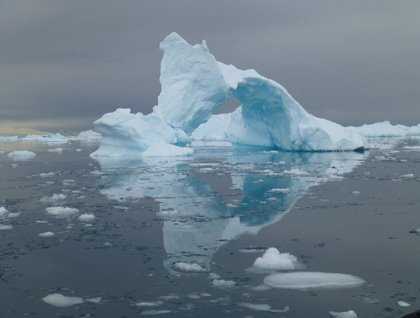We awoke this morning to the sounds of something scrapping and crunching along the sides of the ship. As we looked out our windows the sea was a soup of “bergy bits”. During the night we had made our way into Cierva Cove.
The Zodiac tours were our first chance to get up close and personal with ice and we were all struck by how dynamic it was! The naturalists on board our Zodiacs explained the fluid nature of the ice around us. In no way were we sitting and watching a stationary structure. First there were the currents and movements of the slush and pieces of ice, rolling and shifting through the cove. While the larger bergs appeared to be more stationary, they too were alive with the crackling of internal air bubbles popping under pressure. Then there was the color! It went beyond the expected white and ranged from vibrant blue to green under the influence of refracted light and phytoplankton.
Within minutes of being on the Zodiac a call came over the radio to say that a leopard seal had been spotted on one of the ice pieces. While he spent most of his time laying motionless on the ice, he did give us a good yawn and visual of his gnarly tricuspid teeth specialized for filtering out the krill, which makes up 60% of its diet. In true Lindblad style, a Zodiac appeared bearing hot chocolate for us to sip while we enjoyed the majestic landscape around us. After our morning excursion we listened to a presentation on ice and glaciers, which served to enrich our earlier experiences with the ice.
We arrived at Enterprise Island, and found that the conditions were much choppier than the still water we had just been in. This made for a chilly and wet zodiac tour but it was worth it for the view of a shipwreck. We were again blown away by the colors and shapes in the snow and ice around us.
Prior to dinner we treated to a number of different presentations in the lounge. The National Geographic photographer on board spoke about using photos to tell a story, using her experiences in Alaska as an example. This was followed by two of the naturalists on board teaching us about Antarctic seals. They encouraged us to become citizen scientists by providing them with our images of leopard seals that might be used for identification. During the daily recap, they surprised us with an extra excursion planned for the later in the evening.
Danco Island held our first Gentoo penguin colony and we had a chance to hike 1000 feet up to the top of Spigot Peak. The strenuous climb was rewarded with spectacular vistas, including Antarctica’s version of a summer sunset. For those people who chose not to go all the way to the top there was the opportunity to sit and observe penguins as they traveled up and down the penguin highway. We were careful to sit in silence so that we did not disturb them and cause them to alter their path or behavior.






